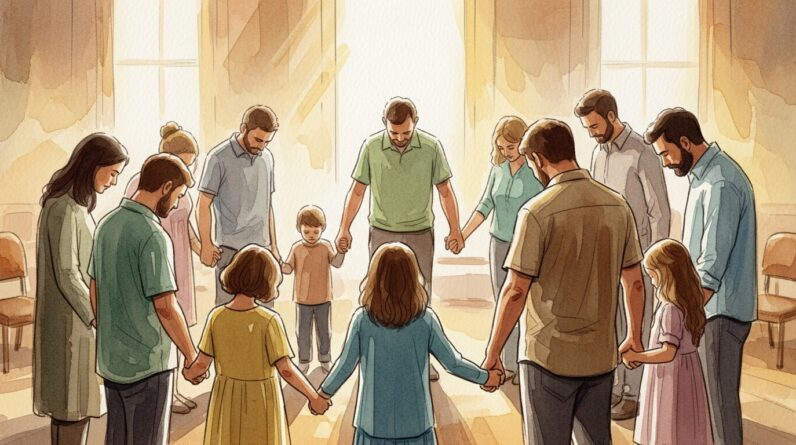Restoring Peace In The Church: Overcoming Division With Love

You lead a church. You care about souls, worship, and the mission God has given your congregation. When conflict arrives (and it will), it tests everything you’ve built: trust, witness, relationships, and your ability to steward unity in the church. This article is written directly to you—the pastor, elder, deacon, ministry leader—who wants not only to stop the bleeding of division but to heal and strengthen the body through gospel-shaped love. You’ll find biblical guidance, practical steps, and conversation starters you can use immediately to restore peace and rebuild unity in the church.
Unity isn’t an optional luxury; it’s a kingdom imperative. Jesus prayed that his followers would be one so the world might believe in him. When fragmentation takes root, your church’s witness is dulled and members are harmed. You’re not aiming for superficial agreement—you’re aiming for a robust, sacrificial community where differences are held together by love. Throughout this article, you’ll see Scripture woven into practical counsel; every Bible reference links to Bible Gateway so you can read the verses in full and in context.
Why unity matters: theology and witness

Unity in the church is theological first. You don’t assemble people because you like the idea of community; you assemble them because the triune God gathers diverse sinners into one body through the work of Christ. Jesus prayed, “that they may all be one”—not as a nice add-on, but as a direct petition for your church’s witness and the world’s salvation. See John’s account of Jesus’ prayer: John 17:21.
When you foster unity in the church, you’re living out the gospel publicly. Paul urges believers to make every effort to keep the unity of the Spirit through the bond of peace: Ephesians 4:3. That “effort” means work; it’s proactive. Unity doesn’t magically appear when people are “nice enough.” It requires intentional leadership, humility, and practices that bind a congregation together.
Your church’s witness depends on unity because division undermines credibility. When outsiders see Christians at odds, they ask why the gospel didn’t change relationships. Your duty is to embody a reconciled community so that the message of grace is reinforced by visible love. Scripture repeatedly links love and unity: “Above all, clothe yourselves with love, which binds everything together in perfect unity” Colossians 3:14. That’s not optional—it’s essential.
Recognize the common causes of division

To restore peace, you need to diagnose. Division rarely appears out of nowhere; it grows from identifiable roots. Pride, poor communication, unmet expectations, broken systems, competition for leadership, theological misunderstanding, and unresolved offense are frequent culprits. When you understand the causes, you can address them specifically rather than solely treating symptoms.
Pride and self-protection are powerful engines of division. Paul exhorts you to humility and putting others before yourself: Philippians 2:1-4. When individuals seek status or protect their reputation at the expense of others, unity fractures. Another common culprit is gossip and rumor. Unchecked talk about leadership decisions or personal matters corrodes trust faster than most problems appear.
Structures matter. If your church lacks clear conflict-resolution pathways, people invent their own. That often means gossip, factions, and social media battles. You need systems that redirect grievances into processes that honor both truth and restoration. Matthew provides a direct, procedural path for resolving sin between believers: Matthew 18:15-17. Leaders should not treat that passage as optional but teach and model the steps.
How sin, offense, and wounds differ—and why that matters
Not all relational ruptures are the same. Sin that injures someone’s reputation or safety is different from a misunderstanding, and both differ from wounds caused by unhealed trauma. You’ll need to discern whether an issue requires personal reconciliation, a formal mediation, or pastoral care. The wrong response deepens harm: a hurried “forgive and forget” can retraumatize, while an overly punitive response can fracture relationships unnecessarily.
Paul’s prescription for restoration includes gentleness and spiritual humility: “Brothers and sisters, if someone is caught in a sin, you who live by the Spirit should restore that person gently” Galatians 6:1. That instruction shapes your posture as a leader—you restore, not shame; you aim to reclaim the lost, not punish for punishment’s sake.
The biblical model for reconciliation

The Bible offers a clear ethic for addressing offenses. It presumes relationships will suffer harm and provides a pathway that prioritizes repentance, forgiveness, and restoration. Start with personal confrontation when appropriate—Matthew 18 lays out this private-to-public progression. If the conflict escalates, the community may need to step in. If reconciliation isn’t possible, there are measures for the church’s good; even then, discipline is meant to lead to repentance, not merely to exclude.
Forgiveness is non-negotiable for Christians, but it’s not a simplistic or immediate transaction. Ephesians encourages you to be kind and compassionate, forgiving one another just as God forgave you in Christ: Ephesians 4:32. That verse shapes the pastoral approach—while you hold people accountable, you also cultivate a climate where forgiveness can take root.
Restoration also involves communal responsibility. You don’t leave reconciliation to private morality; the church is an organism where members are to carry each other’s burdens: Galatians 6:2. When the whole congregation accepts responsibility for one another’s spiritual health, restoration becomes a shared mission rather than a one-person burden.
Practical first steps you can take this week
When a conflict comes across your desk, don’t rush. Begin with prayer and scripture: ask for wisdom, humility, and words that heal. Then apply these practical steps: listen carefully to each party, convene a mediated conversation, agree on facts, identify hurts and needs, ask for repentance where sin is present, offer forgiveness if appropriate, and agree on a path forward. Document the conversation and follow up.
Practically, teach your congregation the steps of Matthew 18 before they need them. Make mediation resources available and equip small-group leaders in peacemaking skills. Train your team in empathetic listening; often, people just want to be heard before anything else can happen. Remember: restoration is a process, not a one-off event.
Lead with humility: the leader’s posture matters

You set the tone. If you lead with defensiveness, your people will mirror that. If you lead with humility, people will follow. Paul’s exhortation to have the same mindset as Christ is central: humility, service, and putting others first Philippians 2:1-4. That mindset isn’t mere theory; it shapes how you apologize, how you hold meetings, and how you discipline.
Humility also looks like transparency. If a decision caused hurt, admit it, explain the reasoning, and invite correction. When leaders are open about mistakes and committed to restoration, it diffuses suspicion and models the gospel. The opposite—secrecy and unilateral action—fuels conspiracy theories and division.
Part of leadership humility is resisting the urge to “fix” everything immediately. Some wounds need time and consistent love. Make space for grief, anger, and doubt while keeping the long-term goal of reconciliation in view. You’re shepherding souls, and shepherds stay with the sheep through their slow healing.
Communication that heals: how to run reconciliatory conversations

Good communication is the oxygen of unity in the church. A few practical habits will serve you well: ask open-ended questions, reflect on what you hear, summarize shared facts, and resist immediately offering solutions. Use “I” statements to reduce accusations and name needs rather than assigning motives. When you enforce boundaries, explain the pastoral reasoning; people accept boundaries better when they understand the “why.”
If you’re mediating, set norms: no interrupting, no side conversations, speak from personal experience, time limits if needed, and a commitment to confidentiality where appropriate. Encourage participants to identify what they need for repair: apology, restitution, changed behavior, or assurance. Make a follow-up plan and set a date to revisit the outcomes.
Remember that silence can be as powerful as speech. Sometimes you must hold space for emotion without rushing to fill it with theology or logic. Empathic presence signals you value the person more than your agenda—this is essential to restoring trust.
When Scripture guides the tone
Scripture gives not only the steps but the tone: gentleness, patience, and a focus on restoration. The counsel in Galatians about restoring a brother or sister gently, Galatians 6:1, matters more than mechanical compliance with rules. Paul’s advice in Romans encourages you to live at peace with everyone as far as it depends on you Romans 12:18. That doesn’t mean you consent to sin, but you pursue peace without surrendering truth.
Care for the wounded and the guilty

Healing must attend to both victims and offenders. Victims need validation, pastoral care, practical help, and assurance of safety. Offenders need accountability, repentance, and a path toward making amends. Craft pastoral care plans tailored to the situation: counseling, temporary role adjustments, restitution agreements, and prayerful supervision.
Scripture calls you to be tenderhearted and forgiving, but also wise. Paul tells you to forgive as God forgave you in Christ, Ephesians 4:32. That forgiveness isn’t flippant; it’s often accompanied by consequences until trust is rebuilt. Your discipline structures should aim at the person’s restoration and the congregation’s protection.
You’ll need to discern when to encourage private reconciliation and when to bring formal mediation. Small hurts sometimes resolve in conversation; significant harms—especially those involving abuse or criminal activity—require immediate protective measures and reporting. Understand the difference and have clear policies.
Rebuilding trust and transparent structures

Trust is fragile and slow to grow. When it’s broken, you must rebuild it intentionally. Transparency is crucial: explain decisions, share financial reports, invite questions, and avoid inner circles that exclude. Create structures for involvement—oversight boards, regular Q&A forums, published policies on complaints—so people see that governance is not arbitrary.
Train elders and leaders in conflict mediation and spiritual care. Clear role descriptions and expectations reduce turf battles. When committees or teams make decisions, document why they were made and how people were consulted. When mistakes happen, leaders must model accountability immediately.
A practical tool is the “reconciliation covenant”: a written agreement after mediation that lists offenses, commitments, follow-up dates, and mutual expectations. That document functions not as legalism but as a roadmap for rebuilding trust while providing clarity.
Preventing future divisions through discipleship and mission

Prevention beats cure. Keep teaching on unity in the church as a regular part of discipleship. Preach and teach the theology of the church, the practical rhythms of reconciliation, and the expectations for interpersonal behavior. Encourage small groups to practice loving accountability and to use Scripture as the lens for evaluating behavior.
A strong shared mission reduces petty disputes. When everyone focuses on an outward gospel task—loving the neighborhood, evangelism, local mercy ministries—the petty turf battles drain away. Unity finds its strongest glue in shared mission and mutual submission for that mission’s sake. Paul urges believers to “make every effort to keep the unity of the Spirit” Ephesians 4:3; discipleship and mission are the practical expression of that effort.
Develop peacemaking training in your church: short workshops, role-play exercises, and scripts for Matthew 18 conversations. Equip the next generation of leaders with these habits so unity culture becomes embedded, not episodic.
When you need outside mediation or formal discipline
Some conflicts exceed local capacity. If patterns persist, harm escalates, or safety is at risk, call in trained mediators, denominational leaders, or professional counselors. Don’t allow pride to delay bringing in help; outside mediators can provide an impartial perspective and processes you may not have the bandwidth to maintain.
Church discipline, when necessary, is for restoration and the purity of the body. When a member persistently refuses to repent and their behavior harms the community, steps in Matthew 18 may lead to more formal separation for the sake of repentance or protection. Follow Scripture carefully and involve appropriate oversight: Matthew 18:15-17. Also consult passages that discuss church life and accountability so you act with biblical integrity.
When to involve civil authorities is also a pastoral judgment. Crimes, abuse, or illegal behavior require reporting to the appropriate authorities immediately. Protecting the vulnerable is not optional; it is a moral and legal responsibility.
Maintaining unity long-term: rituals, rhythms, and renewal
Sustained unity grows in the daily rhythms of church life. Worship that focuses on Christ, communal confession, shared sacraments, and corporate prayer cultivates a sense of belonging beyond programs. Rituals—like corporate reconciliation services, public confession moments when appropriate, and celebrations of reconciled relationships—remind the body that forgiveness is real and public.
Create renewal rhythms: an annual reconciliation weekend, leadership retreats focused on unity in the church, and ongoing small-group check-ins. Encourage testimony in public worship of how reconciliation changed lives. Those stories build communal identity and resilience when fresh conflicts arise.
Finally, never undervalue prayer. Ask God to bind hearts with love that grows out of knowledge of Christ. Pray Scripture: for example, Jesus’ prayer for unity, John 17:21, can be prayed corporately as a liturgy for asking God to make unity visible.
Final encouragement: you are not alone in this work

Restoring peace in the church is hard work, but it’s the work of your Savior. You don’t do it alone. Depend on Scripture, prayer, wise counsel, and the Holy Spirit. Build systems so goodwill isn’t the only thing holding your community together. Teach your people to love each other as Christ loved the church. Keep circling back to the gospel: your unity is not merely organizational—it testifies to what Christ has accomplished when diverse sinners become one people under his Lordship.
Remember Paul’s words that above all things you are to put on love, which binds everything together in perfect unity Colossians 3:14. Let that gospel-shaped love lead you toward forgiveness, toward accountability, and ultimately toward a church that reflects the reconciliatory heart of God.
If you want to start a concrete next step tomorrow: gather your leadership team, read Matthew 18 together, and draft a simple conflict-resolution flowchart for your church—what conversations happen first, who mediates, and how follow-up will be handled. Put it on the church website and teach it in a sermon or class. Small clarity steps cut off many future conflicts before they even start.
Explore More
For further reading and encouragement, check out these posts:
👉 7 Bible Verses About Faith in Hard Times
👉 Job’s Faith: What We Can Learn From His Trials
👉 How To Trust God When Everything Falls Apart
👉 Why God Allows Suffering – A Biblical Perspective
👉 Faith Over Fear: How To Stand Strong In Uncertain Seasons
👉 How To Encourage Someone Struggling With Their Faith
👉 5 Prayers for Strength When You’re Feeling Weak

📘 Jesus and the Woman Caught in Adultery – Grace and Mercy Over Judgement
A powerful retelling of John 8:1-11. This book brings to life the depth of forgiveness, mercy, and God’s unwavering love.
👉 Check it now on Amazon 🛒💥
🔥 “Every great message deserves a home online.” 🌍💬🏡
Don’t let your calling stay hidden. Start a Christian blog or website using Hostinger — with 99.9% uptime, a free domain, and SSL, your voice can shine for God’s glory anytime, anywhere.
💥 Begin today. 🛒 Try it RISK-FREE! ✅
✝️ “Your body is God’s temple — care for it with purpose.” 💪💖🏛️
Renew your energy and restore balance naturally. Mitolyn helps support a healthy metabolism, giving you the vitality to live out God’s calling with strength and confidence.
🔥 Unlock Your Metabolic Power! ⚡Burn More Calories & Feel Great With Mitolyn. 💪
👉 Start Today. 🚀 Check Price Now. 🛒💰
💰 As a ClickBank & Amazon Affiliate, I earn from qualifying purchases.
📖 Acknowledgment: All Bible verses referenced in this article were accessed via Bible Gateway (or Bible Hub).
🚀 Want to explore more? 👉 Dive into our new post on Why Jesus? and experience the 🔥 life-changing truth of the Gospel!





